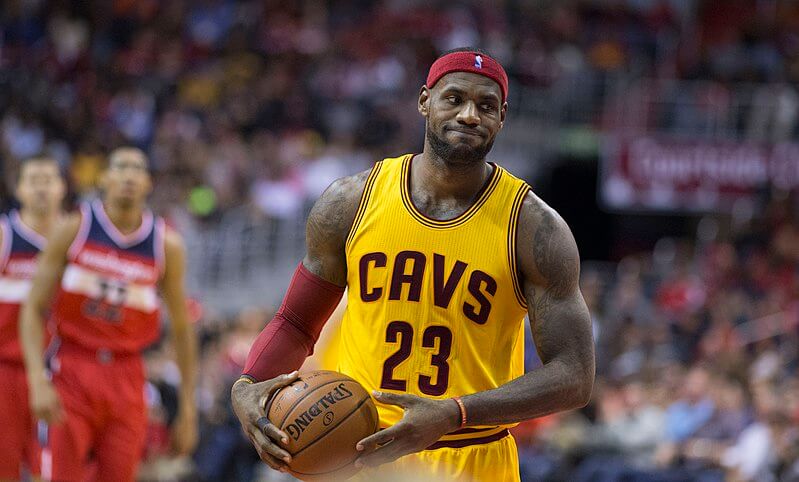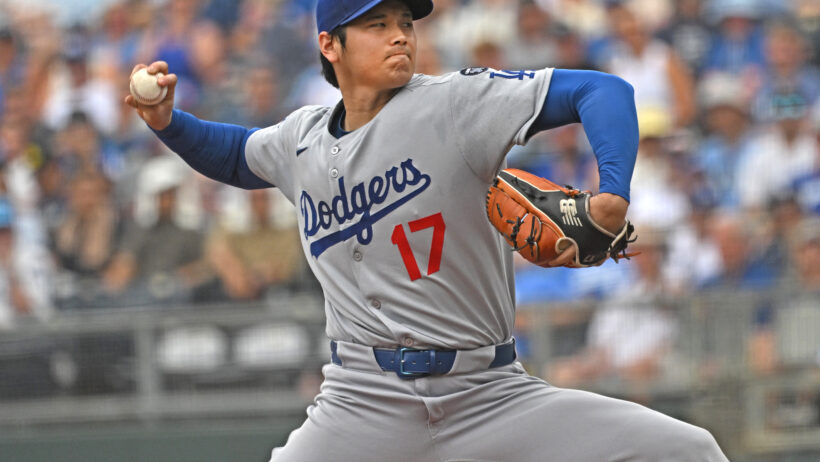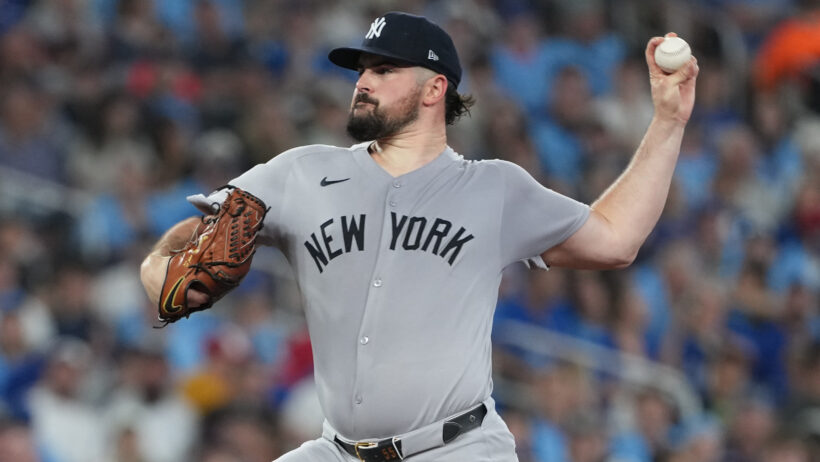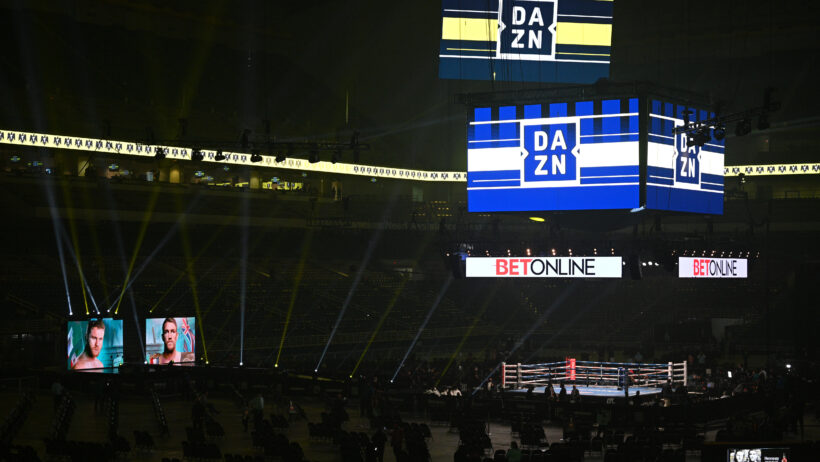Are the 2018 Playoffs LeBron’s Greatest Achievement?
By Ryan Murphy in NBA Basketball
Published:

- LeBron James is averaging 34 points, 9.2 rebounds, and 8.8 assists in the 2018 Playoffs and has been a one-man wrecking crew
- Did the 2006-07 Cavs provide LeBron with more support than he’s receiving now?
- Is LeBron’s 2018 Playoff push the greatest accomplishment of his 15-year career?
The consensus among NBA fans prior to the 2018 Playoffs was that LeBron James’ greatest achievement was leading the 2006-07 Cavs to the NBA Finals. That team, as you may recall, was a deeply flawed squad full of unwanted castoffs and forgotten journeymen who were lucky to have a job.
That perception has slowly begun to change, however, as LeBron has dragged the 2017-18 Cavs kicking and screaming through the league’s playoff gauntlet. The 14-time All-Star has had to deliver MVP performances on a nightly basis as his undermanned and overwhelmed teammates have stood idly by.
So, which is more impressive: LeBron’s heroics in 2007 or 2018? We’ve crunched the numbers to determine which roster supplied King James with the least amount of support. We’ll begin by looking at how both teams performed in the regular season to get a sense of what they were made of.
Comparing Regular Seasons
The 2006-07 and 2017-18 Cavs finished with identical 50-32 records during the regular season, but they couldn’t have been more dissimilar. LeBron’s first Finals squad was a gritty, no-nonsense team that played smash mouth basketball from the opening tip to the final whistle.
They crashed the glass relentlessly, played tenacious defense and wore down their opponents until they begged for forgiveness. They finished the season with the NBA’s fourth best defensive rating, and were first in three-point defense and second in rebounds.
The 2006-07 Cavs ranked 19th in offensive rating and points per game, and would have had difficulty scoring 100 points even if you spotted them with a 92-point lead.
It’s a good thing they played such staunch defense, because their offense was downright offensive. The 2006-07 Cavs ranked 19th in offensive rating and points per game, and would have had difficulty scoring 100 points even if you spotted them with a 92-point lead.
LeBron was the only player on the team with an effective field goal percentage above 50% and eight players shot 28% or worse from the three-point line.
OFFENSE
| 102.6 (19) | Offensive Rating | 110.6 (5) |
| 96.8 (19) | Points | 110.9 (5) |
| 20.8 (15) | Assists | 23.4 (12) |
| 43.5 (2) | Rebounds | 42.1 (23) |
| 44.7 (24) | Field-Goal Percentage | 47.6 (5) |
| 35.2 (18) | Three-Point Percentage | 37.2 (6) |
| +3.8 (7) | Plus/Minus | +0.9 (14) |

DEFENSE
| 98.9 (4) | Defensive Rating | 109.5 (29) |
| 92.9 (5) | Points | 109.9 (26) |
| 44.8 (8) | Field-Goal Percentage | 47.4 (28) |
| 32.9 (1) | Three-Point Percentage | 36.8 (22) |
| 38.1 (9) | Points In The Paint | 47.0 (21) |
The 2017-18 Cavs, by contrast, play as if they’re allergic to defense. They ranked 29th this season in defensive rating and surrendered 120 points or more 15 times. Aside from LeBron, only one other player finished with a Defensive Win Share above 1.0.
The Cavs’ saving grace during the 2017-18 regular season was their above average offense. They ranked fifth in offensive rating, field goal percentage, and points per game, and had a penchant for outscoring lesser opponents during the regular season. It wasn’t always pretty, but it did lead to the fourth best record in the Eastern Conference.
The 2006-07 Cavs were certainly a more balanced bunch in the regular season, but how did the do under the bright lights of the playoffs when the game slows down and superstars are expected to step up? Let’s take a look…
Comparing NBA Playoffs
The 2006-07 Cavs entered the playoffs as the second seed in the Eastern Conference. They easily swept the seventh-seeded Wizards in the first round, knocked off the sixth-seeded Nets in the second round, and eliminated the Pistons in six games in the Eastern Conference Finals.

By contrast, the 2017-18 Cavs entered the playoffs as the fourth seed in the Eastern Conference. They needed seven games – and a lot of lucky bounces – to squeak past the Pacers. They then swept the Raptors and went the distance against the Celtics.
In some respects, the 2006-07 Cavs had an easier path as the East’s second seed, but the quality of players they faced were far superior.
In some respects, the 2006-07 Cavs had an easier path as the East’s second seed, but the quality of players they faced were far superior.
New Jersey had a pair of Hall of Hamers in Jason Kidd and Vince Carter, while Detroit had a stacked line-up with six current and former All-Stars in Chauncey Billups, Rip Hamilton, Tayshaun Prince, Rasheed Wallace, and Chris Webber.
The Pistons played elite defense, were remarkably tough, and had the league’s sixth best offensive rating and seventh best defensive rating.
| Year | MPG | PPG | RPG | APG | BPG |
|---|---|---|---|---|---|
| 2007 | 44.7 | 25.1 | 8.1 | 8.0 | 0.5 |
| 2018 | 41.3 | 34.0 | 9.2 | 8.8 | 1.1 |
You would think that LeBron would have had to play a bigger role in 2006-07 given the quality of the opposition the Cavs faced, but the opposite is true. James actually averaged 8.9 points less in the 2007 Playoffs and Cleveland still advanced to the NBA Finals.
| Year | USG% | OWS | DWS | WS | VORP |
|---|---|---|---|---|---|
| 2007 | 29.7 | 2.1 | 1.6 | 3.7 | 2.4 |
| 2018 | 35.9 | 3.5 | 1.0 | 4.5 | 3.1 |
In fact, virtually all of LeBron’s stats were lower during the 2007 Playoffs as his teammates repeatedly picked up the slack. His usage rate was 6.2% less and his Offensive Win Share (OWS), Win Share (WS), and Value Over Replacement Player (VORP) were all lower than in 2018.
One of the biggest differences between the two squads is that the 2006-07 team was capable of winning even when LeBron had an off night. That was the case in the first game of their opening series against the Wizards, when they pulled off a 97-82 win after LeBron sprained his ankle in the third quarter.
It happened again in Game 6 of their second round series against the Nets, when they secured a 88-72 win despite the fact LeBron sat for long stretches with foul trouble and chipped in just 23 points.
We now know that the 2006-07 Cavs did a better job of taking the pressure off LeBron in the playoffs. Let’s take a look at the calibre of his teammates next.
Comparing Teammates
It’s easy to make fun of the 2006-07 Cavs. After all, their center looked like Uncle Fester and their power forward was the spitting image of Sideshow Bob. Hell, they even had a guy named Boobie.

Although they may not have looked terribly fearsome, LeBron’s teammates were excellent role players who were remarkably tough and played exceptional defense.
Drew Gooden, Anderson Varejao, and Zydrunas Ilgauskas all ranked in the top 25 in rebounds per 48 minutes and did an outstanding job of guarding the paint and limiting second chance points.
| Player | MPG | PPG | RPG | APG |
|---|---|---|---|---|
| Larry Hughes | 37.1 | 14.9 | 3.8 | 3.7 |
| Drew Gooden | 28.0 | 11.1 | 8.5 | 1.1 |
| Zydrunas Ilgauskas | 27.3 | 11.9 | 10.6 | 3.3 |
| Anderson Varejao | 23.9 | 6.8 | 6.7 | 0.9 |
| Eric Snow | 23.5 | 4.2 | 2.3 | 4.0 |
It’s possible that someone on the 2017-18 Cavs knows how to play defense, but they have yet to show it in front of a live audience. This current iteration of the Cavaliers prefers to defeat opponents instead by outscoring them.
Kevin Love is the only other Cavalier averaging double figures and Cleveland is averaging just 86 points in its six playoff defeats.
That works in principle, but Cleveland simply hasn’t supplied LeBron with enough support during the 2018 Playoffs. Kevin Love is the only other Cavalier averaging double figures and Cleveland is averaging just 86 points in its six playoff defeats.
As good as LeBron is, he can’t be the only one putting the ball in the hoop.
| Player | MPG | PPG | RPG | APG |
|---|---|---|---|---|
| Kevin Love | 28.0 | 17.6 | 9.3 | 1.7 |
| Jordan Clarkson | 22.6 | 12.6 | 2.1 | 1.7 |
| Rodney Hood | 25.3 | 10.8 | 2.6 | 1.4 |
| Jeff Green | 23.4 | 10.8 | 3.2 | 1.3 |
| George Hill | 27.9 | 9.4 | 2.7 | 2.8 |
One of the best ways of measuring player values over different years or eras is to look at VORP, which takes into account a player’s overall contribution to his team compared to what a theoretical replacement player would provide.
The combined VORP of the 2006-07 Cavs was 4.6 compared to 2.6 for this year’s squad. That speaks volumes about the lack of quality players on Cleveland’s current roster.
| 11.8 | Combined Offensive Win Shares | 16.8 |
| 25.9 | Combined Defensive Win Shares | 8.0 |
| 38.8 | Combined Win Shares | 26.4 |
| 2.77 | Average Win Shares | 1.88 |
| 4.6 | Combined VORP | 2.6 |
Conclusion
LeBron was phenomenal during the 2007 Playoffs, but he’s been positively super human in 2018. He’s put the Cavaliers on his back and is single-handedly responsible for securing their spot in the NBA Finals.
The 2006-07 Cavs may not have had a lot of household names (or at least not ones you can pronounce), but at least they understood that basketball is a team sport. They overcame their individual limitations and won games through heart, hustle, and vastly superior defense.
Sure, they rode LeBron’s coattails from time to time too, but they also bailed him out when he was limited by injuries and foul trouble.
Lifting the 2017-18 Cavs to the NBA Finals has indeed been LeBron’s greatest triumph. Few others players in NBA history could turn a mediocre lottery-bound team into a legitimate NBA title contender.

Former Sports Writer
Ryan worked as an Editor and resident Lead NBA and MLB Writer for SB from 2017-19. He has authored his own weekly columns for Fox Sports and AskMen, and has created successful campaigns for the WWE, the NHL, and the NFL. Ryan's critically acclaimed stories have been published in 20 books.



